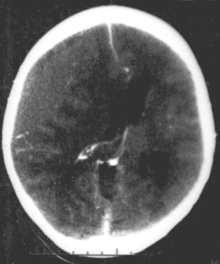| Focal and diffuse brain injury | |
|---|---|
 | |
| Epidural hematoma, an example of a focal injury |
Focal and diffuse brain injury are ways to classify brain injury: focal injury occurs in a specific location, while diffuse injury occurs over a more widespread area. It is common for both focal and diffuse damage to occur as a result of the same event; many traumatic brain injuries have aspects of both focal and diffuse injury.[1] Focal injuries are commonly associated with an injury in which the head strikes or is struck by an object; diffuse injuries are more often found in acceleration/deceleration injuries, in which the head does not necessarily contact anything, but brain tissue is damaged because tissue types with varying densities accelerate at different rates.[2] In addition to physical trauma, other types of brain injury, such as stroke, can also produce focal and diffuse injuries.[1] There may be primary and secondary brain injury processes.
- ^ a b
Lovell MK, Franzen MD (1994). "Neuropsychological assessment". In Silver JM, Yudofsky SC, Hales RE (eds.). Neuropsychiatry of Traumatic Brain Injury. Washington, DC: American Psychiatric Press. pp. 152–3. ISBN 0-88048-538-8. Retrieved 2008-06-17.
Although brain injuries are often described as diffuse or focal in nature, in reality many traumatic brain injuries have both focal and diffuse components.
- ^ Cite error: The named reference
Gennarelli04was invoked but never defined (see the help page).